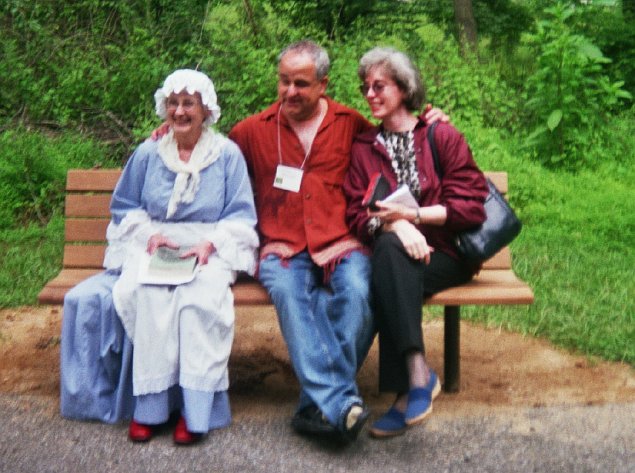

Page 4 of 5
Memorials in Sligo Park
- Memory is a man's real possession. In nothing else is he rich.
- Alexander Smith
Memorials on this page are described in order from Forest Glen Road upstream to Dennis Avenue.
Bibi Khan
A small stone memorial, painted for a neighbor, is tucked under a tree on the north side of Woodman Avenue between the holding dams and the road bridge a block down the street. The stone was discovered during a Friends of Sligo Creek walk in early spring 2003. Plant growth hides it later in the season.

A neighbor and friend painted the stone and placed a crepe myrtle tree above - an older variety which was more likely be hardy. The neighbor reports that Bibi was a delightful woman who died suddenly and unexpectedly from a heart problem.
|
|||||
Denis Martin Wolf
A plaque was placed on each of four benches in memory of Denis Martin Wolf.
Denis was 17 in 1974 when he and others rode bicycles up Sugarloaf Mountain in Comus, Maryland. A car with a drunk driver came down the road, hit Denis and killed him. The driver served thirty days in jail. The Wolf family had lived on Dennis Avenue, and Denis attended Forest Grove Elementary, Sligo Middle School, and Northwood High. He would have entered the University of Maryland the following year.

Two benches were placed on the Trail between the Dennis Avenue Recreation Center and Dennis Avenue.
In memory of Denis the family provided a bikeway installation between a site in Prince Georges County and the University of Maryland, so that students could avoid streets.

The family also wanted a memorial near home. Observing that children climbed over the sculpture Whispers, and that there was nowhere nearby to sit,
A niece of Denis later wanted a Girl Scout Gold Award project, and conceived the idea of a garden near the benches. It was built in 1998 with money contributed by the local chapter of MADD. The family makes a small contribution for changing flowers in pots and keeping the garden trim.

Whispers seen from several angles. The sculptor's signature is on a shoe. |
|||||
 |
 |
||||
 |
 |
||||
| Whispers was purchased by M-NCPPC from artist Steven Weitzman, in about 1972. Weitzman, born in New York, lived in Takoma Park for a time. He is known for large-scale public works, which include the sculpture at the National Zoo entrance on Connecticut Avenue and the indoor sculpture of tree-tending in the Judicial Center Building, Rockville. | |||||
A Memorial to James and Mary Lee
| |||||
 |
 |
 |
 |
About James and Mary Lee
James Lee (1680/85 - 1764)
Mary Lee (1690/95 - 1762)
The following information is from Ann Littlefield Coleman, author of a historical novel about the area.
James and Mary Lee, of Irish background, came here from Charles County. James was born locally, in Prince Georges County. Twelve children were born to the couple. The ninth child, Rebeckah Lee (1728-1806), married William Littlefield (c1725-1788) after her family moved to Chestnut Ridge. They had married by 1750 and remained when her parents died. James Lee's will stated, "I give to my loving wife Mary Lee the tract of land I now live on called Chestnut Ridge containing by estimation one hundred acres to hold to her the said Mary Lee during her natural Life, she making no willful Waste or Destruction thereupon and after her decease I give and devise to my daughter Rachel Lee ..."
Kayla say that from tax records descendants know that James and Mary had relatively little money, and lived in a cabin of 30 feet to a side. This was average, "the size of a single wide trailer, with probably a loft for sleeping quarters." James Lee's estate papers show that "he did not die broke, but he wasn't rich either."
While the land is referred to in records as a plantation because James' occupation was a "planter," there is no reason to believe the family owned slaves. Slaves would have been mentioned in James' will or in the inventory of the estate. James grew tobacco for sale at auction.
Ninth-generation descendant Robert E. Lee, Jr. says, "By the late 1700s, the area was likely fairly well developed, as tax records show it had more than a few tenements/tenants by the 1760s."


Ann Coleman's book is titled Leaves of Chestnut Ridge, and she writes, "When researching for my novel I decided to just check out the Maryland group to see if I could add a chapter or two about that part of the family tree. After researching the colonial history of Maryland I could not leave. It became the location of the entire novel. Later when visiting the area I had wanted to go there and hand out a novel to someone living in the area. There was a young mother waiting for a school bus with a baby in a stroller. I saw the worried look on her face as we drove past and decided she probably thought we might be out to snatch her baby. After that I gave up on the idea of handing out a novel. I just wanted someone living on the land to enjoy the history of their place. Maybe someday that will happen."
Ann Coleman's book is based on family lore and facts she gleaned from courthouses. Buy the book here.